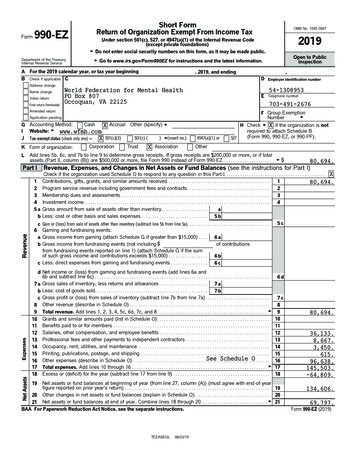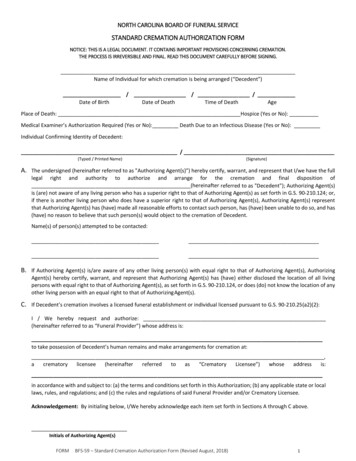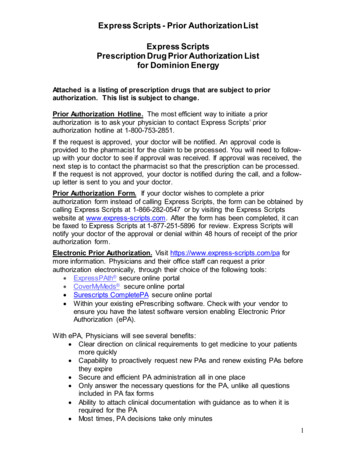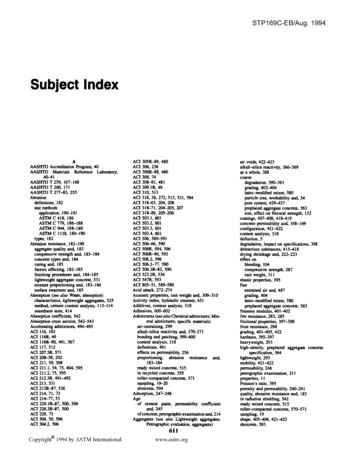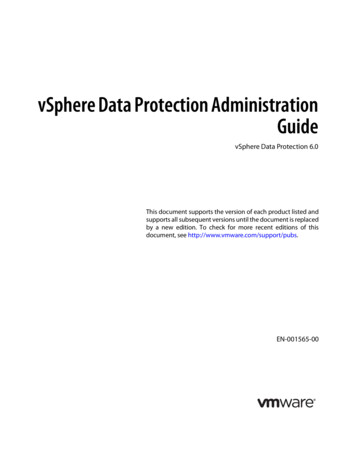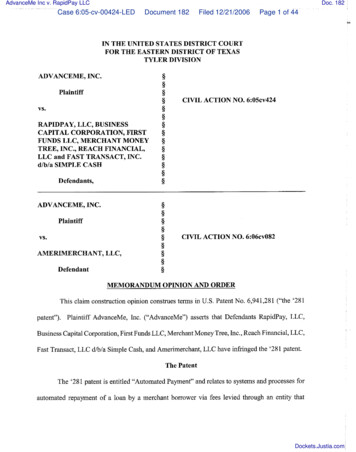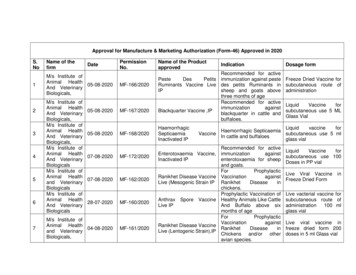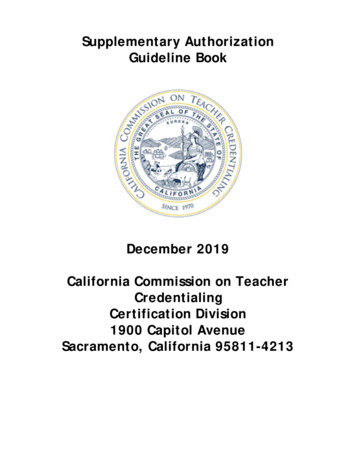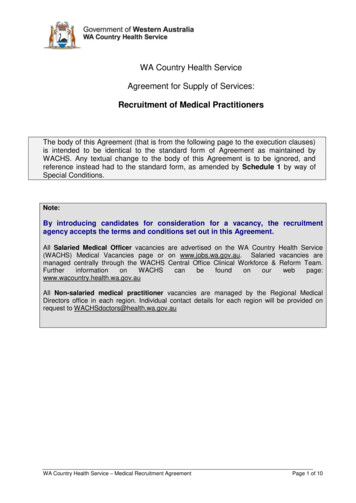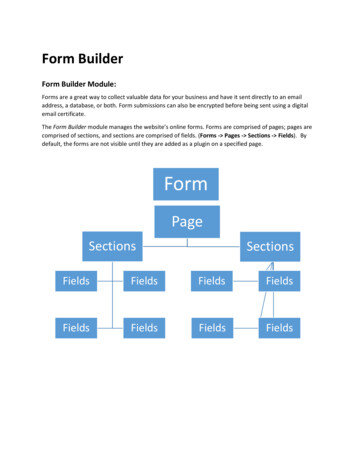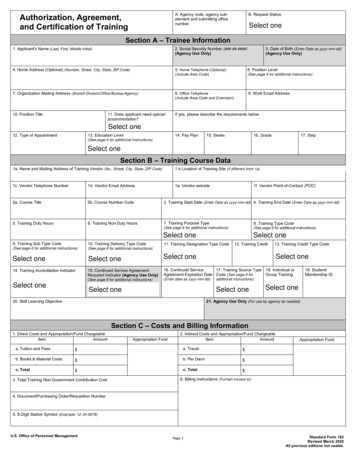
Transcription
A. Agency code, agency subelement and submitting officenumberAuthorization, Agreement,and Certification of TrainingB. Request StatusSelect oneSection A – Trainee Information1. Applicant's Name (Last, First, Middle Initial)2. Social Security Number (###-##-####)(Agency Use Only)4. Home Address (Optional) (Number, Street, City, State, ZIP Code)5. Home Telephone (Optional)3. Date of Birth (Enter Date as yyyy-mm-dd)(Agency Use Only)6. Position Level(Include Area Code)(See page 4 for additional instructions)7. Organization Mailing Address (Branch-Division/Office/Bureau/Agency)8. Office Telephone(Include Area Code and Extension)10. Position TitleIf yes, please describe the requirements below11. Does applicant need specialaccommodation?9. Work Email AddressSelect one12. Type of Appointment13. Education Level14. Pay Plan(See page 4 for additional instructions)15. Series16. Grade17. StepSelect oneSection B – Training Course Data1a. Name and Mailing Address of Training Vendor (No., Street, City, State, ZIP Code)1.b Location of Training Site (if different form 1a)1c. Vendor Telephone Number1d. Vendor Email Address1e. Vendor website2a. Course Title2b. Course Number Code3. Training Start Date (Enter Date as yyyy-mm-dd) 4. Training End Date (Enter Date as yyyy-mm-dd)5. Training Duty Hours6. Training Non-Duty Hours7. Training Purpose Type9. Training Sub Type Code10. Training Delivery Type Code(See page 6 for additional instructions)(See page 8 for additional instructions)Select oneSelect one14. Training Accreditation Indicator15. Continued Service AgreementRequired Indicator (Agency Use Only)8. Training Type Code(See page 6 for additional instructions)(See page 6 for additional instructions)Select oneSelect one11. Training Designation Type Code12. Training Credit13. Training Credit Type CodeSelect oneSelect one(See page 8 for additional instructions)Select one1f. Vendor Point-of-Contact (POC)16. Continued Service17. Training Source Type 18. Individual orAgreement Expiration Date Code (See page 8 forGroup Training(Enter date as yyyy-mm-dd)additional instructions)Select oneSelect one19. Student/Membership IDSelect one21. Agency Use Only (For use by agency as needed)20. Skill Learning ObjectiveSection C – Costs and Billing Information1. Direct Costs and Appropriation/Fund ChargeableItemAmountAppropriation Fund2. Indirect Costs and Appropriation/Fund ChargeableItemAmounta. Tuition and Fees a. Travel b. Books & Material Costs b. Per Diem c. Total c. Total 3. Total Training Non-Government Contribution CostAppropriation Fund6. Billing Instructions (Furnish invoice to)4. Document/Purchasing Order/Requisition Number5. 8-Digit Station Symbol (Example: 12-34-5678)U.S. Office of Personnel ManagementPage 1Standard Form 182Revised March 2020All previous editions not usable.
Section D – ApprovalsComplete the appropriate number of approvals your agency requires (e.g. first, second,and/or third level approval) before submission of this form to the Agency Training Office.1a. Immediate Supervisor/First-line Supervisor (Name and Title)1b. Telephone Number (Include Area Code and Extension)1c. Email Address1d. Signature1e. Date (Enter Date as yyyy-mm-dd)2a. Second-line Supervisor (Name and Title)2b. Telephone Number (Include Area Code and Extension)2c. Email Address2d. Signature2e. Date (Enter Date as yyyy-mm-dd)3a Training Officer (Name and Title)3b. Telephone Number (Include Area Code and Extension)3c. Email Address3d. Signature3e. Date (Enter Date as yyyy-mm-dd)Section E – Approvals/ConcurrenceTo be completed by the nominating Agency Official authorized to approve or disapprove training requests.1a. Authorizing Official (Name and Title)1b. Telephone Number (Include Area Code and Extension)1c. Email Address1d. Signature1e. DateSection F – Certification of Training Completion and Evaluation*1a. Authorizing Official (Name and Title)1b. Telephone Number (Include Area Code and Extension)1c. Email Address1d. Signature1e. DateTraining Facility: Bills should be sent to office indicated in item C6. Please refer to number given in item C4 to assure prompt payment.* Agency Certifying Officials are certifying the employee has completed the requirements for the training and an evaluation has been completed. The requirement to evaluate training is found in 5 CFR 410.202. Theagency head shall evaluate training to determine how well it meets short and long-range program needs of the agency and the individual. The needs should be aligned with the strategic plan to strengthen anddevelop the performance and behavior of the individual whose positive results will impact the performance of the agency.Clear FormPrint FormU.S. Office of Personnel ManagementPage 2Standard Form 182Revised March 2020All previous editions not usable.
Privacy Act StatementAuthority This information is being collected under the authority of 5 U.S.C. § 4115,a provision of The Government Employees Training Act.Purposes and Uses The primary purpose of the information collected is to documentthe approval and completion of employee training within an agency. This completedtraining information must be electronically provided to the Governmentwide systemwhere it will become a part of the permanent employment record and subject to allpublished routine uses of that system of records. Information collected may also beprovided to other agencies and to Congress upon request.Effects and Nondisclosure Providing the personal information requested, in paperform, is voluntary and at the agency’s discretion. However, failure to provide thisinformation electronically to the Governmentwide system may result in errors inprocessing and documenting the training you have completed.Information Regarding Disclosure of your Social Security Number (SSN) UnderPublic Law 93-579, Section 7(b) Solicitation of SSNs by the U.S. Office of PersonnelManagement (OPM) is authorized under provisions of the Executive Order 9397, datedNovember 22, 1943. However, agencies must also safeguard such PersonallyIdentifiable Information (PII) when providing completed training information to theGovernmentwide system. Employee SSNs will be used primarily to give properrecognition for completed training and to accumulate Governmentwide statistical dataand information.U.S. Office of Personnel ManagementPage 3Standard Form 182Revised March 2020All previous editions not usable.
Agency Training Electronic Reporting InstructionsGeneral Instructions:1.You must complete all questions in sections A-E on the training application. In addition, your financialinstitution must complete Section F, Certification of Training Completion and Evaluation section.2.Electronic Requirements - An agency should only submit data for completed training events for whichall mandatory data elements have been recorded.Additional Instructions for Section A - Trainee Information:6. Position Level - Select whether the employee's position level is one of the following:6a. Non-supervisory - Anyone who does not have supervisory/team leader responsibilities.6b. Supervisory - First-line supervisors who do not supervise other supervisors; typically,those who are responsible for an employee's performance appraisal or approval oftheir leave.6c. Manager - Those in management positions who typically supervise one or moresupervisors.6d. Executive - Members of the Senior Executive Service (SES) or equivalent.13. Education Level - Use the employee educational level codes listed below.CodeShort DescriptionLong Description (if applicable)1No formal education or someelementary school--did not completeElementary school means grades 1 through 8,or equivalent, not completed.2Elementary school completed--no highschoolGrade 8 or equivalent completed.3Some high school--did not graduateHigh school means grades 9 through 12, or equivalent.4High school graduate or certificateequivalencyN/A5Terminal occupational program--did notcompleteProgram extending beyond grade 12, usually no more thanthree years; designed to prepare students for immediateemployment in an occupation or cluster of occupations; notdesigned as the equivalent of the first two or three years of abaccalaureate degree program. Includes cooperative trainingor apprenticeship consisting of formal classroom instructioncoupled with on-the-job training.6Terminal occupationalprogram--certificate of completion,diploma or equivalentSee code 5 above for definition of terminal occupationalprogram. Two levels are recognized: (1) The technical and/orsemi-professional level preparing technicians or semiprofessional personnel in engineering and non-engineeringfields; and (2) the craftsman/clerical level training artisans,skilled operators, and clerical workers.7Some college--less than one yearLess than 30 semester hours completed.8One year of college0-59 semester hours or 45-89 quarter hours completed.9Two years of college60-89 semester hours or 90-134 quarter hours completed.10Associate Degree2-year college degree program completed.11Three years of college90-119 semester hours or 135-179 quarter hours completed.12Four years of college120 or more semester hours or 180 or more quarter hourscompleted--no baccalaureate (Bachelor's) degree.13Bachelor’s DegreeRequires completion of at least four, but no more than five,years of academic work; includes a Bachelor's degreeconferred in a cooperative business, industry, or Governmentto allow student to combine actual work experience withcollege studies.U.S. Office of Personnel ManagementPage 4Standard Form 182Revised March 2020All previous editions not usable.
CodeShort DescriptionLong Description (if applicable)14Post-Bachelor'sSome academic work beyond (at a higher level than) theBachelor's degree but no additional higher degree.15First professionalSignifies the completion of academic requirements forselected professions that are based on programs requiring atleast two academic years of previous college work forentrance and a total of at least six academic years of collegework for completion, e.g., Dentistry (D.D.S. or D.M.D.), Law(LL. B. or J.D.), Medicine (M.D.), Theology (B.D.), VeterinaryMedicine (D.V.M.), Chiropody or Podiatry (D.S.C. or D.P.),Optometry (O.D.), and Osteopathy (D.O.).16Post-first professionalSome academic work beyond (at a higher level than) the firstprofessional degree but no additional higher degree.17Master's degreeFor liberal arts and sciences customarily granted uponsuccessful completion of one (sometimes two) academicyears beyond the Bachelor's degree. In professional fields,an advanced degree beyond the first professional but belowthe Ph.D., e.g., the LL.M.; M.S. in surgery following the M.D.;M.S.D., Master of Science in Dentistry; M.S.W., Master ofSocial Work, and MA, Master of Arts.18Post-Master'sSome academic work beyond (at a higher level than) theMaster's degree but no additional higher degree.19Sixth-year degreeIncludes such degrees as Advanced Certificate in Education,Advanced Master of Education, Advanced GraduateCertificate, Advanced Specialist in Education Certificate,Certificate of Advanced Graduate Study, Certificate ofAdvanced Study, Advanced Degree in Education, Specialistin Education, Licentiate in Philosophy, Specialist in Guidanceand Counseling, Specialist in Art, Specialist in Science,Specialist in School Administration, Specialist in SchoolPsychology, and Licentiate in Sacred Theology.20Post-sixth yearSome academic work beyond (at a higher level than) thesixth-year degree but no additional higher degree.21Doctorate degreeIncludes such degrees as Doctor of Education, Doctor ofJuridical Science, Doctor of Public Health, and the Ph.D. (orequivalent) in any field. Does not include a Doctor's degreethat is a first professional degree, per code 15.22Post-DoctorateWork beyond the Doctorate.U.S. Office of Personnel ManagementPage 5Standard Form 182Revised March 2020All previous editions not usable.
Additional Instructions for Section B - Training Course Data:7. Training Purpose Type - Select and insert the purpose for taking this course or program usingthe appropriate training purpose type code from the list below.CodeShort DescriptionLong Description (if applicable)01Program/MissionTraining to provide the knowledge, skills and abilities neededas a result of agency mission, policies, or procedures.02New Work AssignmentTraining to acquire the knowledge, skills and abilitiesneeded as a result of assignment to new duties andresponsibilities when such training is not part of a planned,career development program (e.g., training provided to astaffing specialist who has been newly assigned to a positioninvolving classification duties).03Improve/Maintain Present PerformanceTraining to provide the knowledge, skills and abilities neededto improve or maintain proficiency in present job.04Future Staffing NeedsTraining to provide the knowledge, skills, and abilities neededto meet future staffing needs (e.g., to implement successionplanning).05Develop Unavailable SkillsTraining to acquire the knowledge, skills and abilities neededfor fields of work for which the labor market cannot produce asufficient number of trained candidates (e.g., air trafficcontrollers or Information Technology [IT] professionals).06RetentionTraining/education used to address staffing issue of retainingan employee (e.g., academic degree training).9. Training Sub-Type Code - There are Sub-Type Categories for each of the three (3) different TrainingType Codes. Select one (1) Sub-Type Category code that applies to the training type code you selected.Training Type Code01 - Training ProgramAreaU.S. Office of Personnel ManagementTraining Sub Type CodeCompetency01 - LegalEducation or training in the concepts, principles, and theories, ortechniques of law.Technical02 - Medical and HealthEducation or training in the concepts, principles, and theories, ortechniques of medicine or health sciences.Technical03 - ScientificEducation or training in the concepts, principles, and theories, ortechniques of disciplines such as physical, biological, natural, andsocial sciences; education; mathematics or statistics.Technical04 - Engineering or ArchitectureEducation or training in the concepts, principles, and theories, ortechniques of disciplines such as architecture and engineering.Technical05 - Human ResourcesEducation or training in the concepts, principles, and theories ofsuch fields as Human Resources Management and/or StrategicHuman Capital Management.Human Resources06 - Budget/Finance Business AdministrationEducation or training in the concepts, principles, and theories ofbusiness administration, accounting and finance.Financial07 - Planning and AnalysisEducation or training in the concepts, principles, and theories ofsystems analysis; policy, program or management analysis; orplanning, including strategic planning.Technical08 - Information TechnologyEducation and training in the concepts and application of all facetsof Information Technology.TechnicalPage 6Standard Form 182Revised March 2020All previous editions not usable.
Training Type Code01 - Training ProgramArea (continued)02 - DevelopmentalTraining AreaDescription: Formaldevelopmental/trainingprograms.U.S. Office of Personnel ManagementTraining Sub Type CodeCompetency09 - Project ManagementEducation and training in the concepts, principles, and theoriesnecessary to plan, develop, and modify the management ofproducts, services, or systems with regards to scope, resources,and time.Technical10 - AcquisitionEducation or training in the concepts, principles, and theories ortechniques related to acquiring and procuring goods and servicesfor the government.Financial11 - Logistic SpecialtyTraining for professional skills of a specialized nature in themethods and techniques of such fields as supply, procurement,transportation, or air traffic control.Technical12 - SecurityTraining of a specialized nature in the methods and techniques ofinvestigation in cybersecurity, physical security, personal security,and police science.Technical13 - Administration (Non-supervisory administrative &program/project support)Training in skills used for administrative tasks associated withbusiness/office management and program/project support.Human Resources14 - Trade and CraftTraining in the knowledge, skills, and abilities needed to performand accomplish required tasks in trade and craft occupations (i.e.Carpentry, Plumbing, Electrical, etc.).Technical15 - Foreign AffairsTraining for professional skills of a specialized nature in themethods and techniques of such fields as foreign languages,foreign culture, intelligence (foreign affairs/intelligence),diplomacy, or strategic studies.Technical20 - Supervisory Program/First-Line SupervisorsDevelopment/training program which provides education ortraining in supervisory principles and techniques in such subjectsas personnel policies and practices (including equal employmentopportunity, merit promotion, and labor relations); human behaviorand motivation; diversity and inclusion; communication processesin supervision, work planning, scheduling, and review; andperformance evaluation for first-line supervisors.Leadership21 - Management ProgramDevelopment/training program which provides mid-managementlevel education or training in the concepts, principles, and theoriesof such subject matters as public policy formulation andimplementation, management principles and practices,quantitative approaches to management, or managementplanning organizing and controlling. (Supervisors of supervisors;GS-14/15 supervisors; GS-14/15 direct reports to SES).Leadership22 - Leadership/Manager/Pre-supervisory DevelopmentFormal developmental program that provides mid-level andleadership training and development opportunities for supervisorsand non-supervisors; which includes coursework that addressesskill areas such as Leadership/Management and Communication(e.g., written, oral and interpersonal).Leadership23 - SES Candidate DevelopmentOPM-approved program to prepare potential SES members.Leadership24 - Executive DevelopmentContinuing development for leaders above the GS-15 level.Leadership25 - Mentoring ProgramFormal stand-alone program with established goals and measuredoutcomes. Open to all who qualify; protégées and mentors pairedto facilitate compatibility, training and support provided, andcompany benefits directly.EmployeeDevelopment26 - Coaching ProgramFormal stand-alone program which provides ongoing partnershipwith an employee and coach that helps employee produce desiredresults in professional life.EmployeeDevelopmentPage 7Standard Form 182Revised March 2020All previous editions not usable.
Training Type CodeTraining Sub Type Code03 - Basic Training Area30 - Employee OrientationTraining of a general nature to provide an understanding of theorganization and missions of the Federal Government, employingagency or activity, or a broad overview and understanding ofmatters of public policy.EmployeeDevelopment31 - Adult Basic EducationEducation or training to provide basic completeness in suchsubjects as remedial reading, grammar, arithmetic, lip reading orBraille.EmployeeDevelopment32 - Federally Mandated TrainingMandatory training for all employees Governmentwide. Thisincludes training mandated by federal statute or regulation; suchas in the areas of computer security awareness (5 CFR 930.301305), ethics (5 CFR 2638.703 and 704), or executives, managers,and supervisors (5 CFR Part 412).FederallyMandatory33 - Work-lifeTraining to promote work-life (e.g., health and wellness training,employee retirement/benefits training, etc.).Human Resources34 - Professional SkillsTraining on non-technical skills related to employee performancesuch as communication, conflict resolution, emotional intelligence,organization, time management, etc.Fundamental Skills35 - Agency Required TrainingAgency-specific training required by the agency and provided toFederal employees in order to achieve the goals and objectives ofthe Agency as needed. For example: agency training based onInspector General's Audit; agency training aimed at improvingindividual's needs based on Performance Improvement Plan(PIP); agency training based on signing agreement betweenUnion and Management.Note: Unlike Federally mandated training, this type of training isnot mandated by Federal statute for all Federal employees.Agency RequiredDescription:Fundamental and/orrequired trainingprograms.Competency10. Training Delivery Type CodeCodeShort DescriptionLong Description (if applicable)1Traditional Classroom (no technology)Individual or multiple person led, face-to-face training.2On the JobFormal methods/activities planned and structured to promotelearning by doing; e.g., detail assignments/programs.3Technology BasedMethods mainly using technology, which may includetutorials embedded in software, CD ROM products, Webbased courses, and interactive media.4Conference/WorkshopAn organized learning event which has an announcededucational or instructional purpose; more than half the timeis scheduled for a planned, organized exchange ofinformation between presenters and audience which meetsthe definition of training in 5 U.S.C. 4110; content of theconference/retreat is germane to improving individual and/ororganizational performance; and developmental benefits willbe derived through the employee's attendance.5BlendedTraining that requires two or more methods of delivery thatmust be completed in order to satisfy the educationalrequirements.6CorrespondenceSelf-study course material: Training provided via theassignment of non-interactive methods such as a book,document, regulation, or manual.U.S. Office of Personnel ManagementPage 8Standard Form 182Revised March 2020All previous editions not usable.
11. Training Designation Type Code - Select and insert the appropriate training credit designation type code:CodeShort Description01Undergraduate Credit02Graduate Credit03Continuing Education Credit04Post Graduate Credit05N/A13. Training Credit Type Code - Select and insert the appropriate training credit designation type code only if“training credit” is greater than zero:CodeShort Description1Semester Hours2Quarter Hours3Continuing Education Unit4Professional Development Unit5Continuing Professional Education6Continuous Learning Points7Other15. Continued Service Agreement Required Indicator - (Agency response.) An agency may require anemployee to enter into a continued service agreement (CSA) with the agency prior to authorization for training.According to 5 CFR 410.309, the head of the agency determines the requirements for CSA’s. Typically, whenan employee signs a CSA, an employee agrees to remain in the agency’s service for a specified period of timeafter receipt of training. Indicate whether, or not, the employee signed an agreement to remain in the service ofthe agency for a specified amount of time as a condition of participating in the authorized training. Select Yes(Y), No (N) or non-applicable (N/A).17. Training Source Type Code:CodeShort DescriptionLong Description (if applicable)1Government InternalTraining provided by a Federal department, agency,or independent establishment for its own employees.2Government ExternalTraining provided by an interagency training activity, or aFederal department, agency, or independent establishmentother than the one which currently employs the trainee.3Non-governmentSources include commercial or industrial concern,educational institutions, professional societies orassociations, or consultants or individuals who are notGovernment employees, (but are contracted to developand/or provide training course or program.)4Government: State/LocalTraining provided by a state, county, or municipalGovernment. Education provided by State-operated or otherpublic educational institutions is reported as nonGovernment.5Foreign Governments andOrganizationsTraining provided by non-United States entities which may ormay not be outside the United States.U.S. Office of Personnel ManagementPage 9Standard Form 182Revised March 2020All previous editions not usable.
sixth-year degree but no additional higher degree. 21 Doctorate degree : Includes such degrees as Doctor of Education, Doctor of Juridical Science, Doctor of Public Health, and the Ph.D. (or equivalent) in any field. Does not include a Doctor's degree that is a first professional degree, per code 15. 22 ; Post-Doctorate Work beyond the Doctorate.
